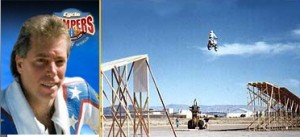“To be the best, learn from the best”
~ Darren LaCroix
 I met Doug Danger a year ago at a speakers’ conference. It was clear right away that this man beamed with positive energy. After a few minutes of talking with him, what was also obvious was how humble he was, despite his extraordinary achievements.
I met Doug Danger a year ago at a speakers’ conference. It was clear right away that this man beamed with positive energy. After a few minutes of talking with him, what was also obvious was how humble he was, despite his extraordinary achievements.
I learned that Doug Senecal (known as Doug Danger to his fans) was a Guinness world record holder for the longest motorcycle ramp-to-ramp jump. He achieved this death-defying feat in 1991 when he cleared 38 cars on his motorcycle at a total distance of 251 feet. That’s 38 cars!!!! Can you imagine??
Then in 1992, Doug had a horrible accident while jumping cars during a show. He broke 17 bones & was in a coma for more than a month. It took him 3 years to regain his memory.
But that didn’t stop Doug from his come-back. In 1999, he broke another world record, this time by clearing 42 cars.
Do you think you can learn a thing or two from this man? Of course!! What impressed me the most were his words of wisdom & his incredible openness & willingness to share them with me & my blog readers.
Here are the first 3 lessons I learned from Doug Danger & how they can be applied to public speaking: (The next 3 lessons will come in a future article)
1) Convince yourself you can do it.
Doug said “Mary, when I set my sights on breaking that first world record, it was a scary thing because nobody had ever done it before. Imagine if it was you. Your life is at risk. You have to mentally prepare yourself”. My biggest surprise was what Doug shared with me next. He continued, “Mary, to me, it wasn’t the fear of not being able to make the jump, it was being ‘booed’ off the stage, looking like an idiot”.
HOW THIS LESSON APPLIES TO PUBLIC SPEAKING
Wow! That is what I call generous honesty. Can you relate to this? I know when I first started public speaking, I worked hard to prepare my speeches & presentations not only to be effective, but also I wanted to avoid looking like an idiot too. Have you experienced this? If so, you are not alone. Many of my clients have as well. This is a human phenomenon – we don’t want to look bad!!! The lesson here is to convince yourself you CAN do it. I say this to my students over & over again: In public speaking, no matter what your subject matter & content, the first person you must convince is yourself.
2) Believe in yourself 100% and visualize your success.
Doug told me: “When you are moving at a hundred miles per hour & 50 feet in the air, you put your life on the line. You must believe in yourself 100%”. I asked Doug how he obtains this unwavering belief in himself. His reply was both simple & profound: “Mary, I have a ritual before every big jump I do. I visually see this jump through in my head. I see the entire jump from start to finish. It’s like the jump has already happened. If I don’t see it, then I’m not ready for the jump yet. In your pursuits, if you have doubts, figure out why you have doubts. Is it that you are focused on the bad things that can happen? If so, think about all the positive things that can happen when you look to the future”.
HOW THIS LESSON APPLIES TO PUBLIC SPEAKING
3) Even our heroes are human.
Growing up, Doug’s hero was the legendary daredevil Evel Knievel. As Doug was learning to jump, he researched Evel Knievel. Doug said, “I realized that he had all the issues I had too, the same challenges”. Once he realized that his extremely accomplished hero had all the same challenges, it was inspiring to him. “I thought, he is human just like I am, and if he can do it, then I can too”.
HOW THIS LESSON APPLIES TO PUBLIC SPEAKING
Have you ever compared yourself to someone more accomplished than you and then felt intimidated? I have. When I sought to learn from the past World Champions of public speaking, the first time I met them, I was intimidated. But when they shared their past failures, I realized they were just like me. Now I find inspiration in them, not intimidation. If they can do it, then I can do it. So now I try to impart that same lesson to my students. I tell them about how self-conscious and awkward I was when I started public speaking.
Once we realize that our heroes are humans and have foibles and challenges just like us, they become real andtouchable & you can say “If he/she can do it, so can I”.
How will you use these 3 lessons to become a better public speaker?
Mary Cheyne, MBA
2009 World Champion of Public Speaking 1st Runner-Up
Keynote Speaker / Trainer / Coach
Magnetic Podium, LLC
617-858-1466
www.MagneticPodium.com

